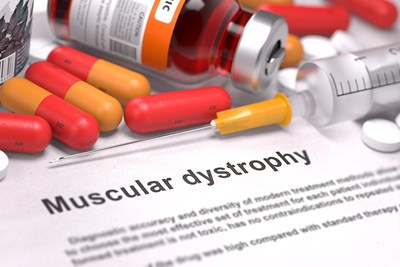Muscular dystrophy is a rare, inherited genetic disease that prevents your body from producing the protein that helps to build your muscles and keep them strong. As a result, your muscles will gradually begin to weaken and deteriorate. In children with muscular dystrophy, the first signs of the condition usually will not develop until after the first few years of life. They will likely include trouble walking, difficulty raising the front of the foot, and general clumsiness and falling. Because muscular dystrophy can also potentially affect the muscles in your heart and lungs, other serious heart and breathing problems can also develop as a result.
Since there are over 30 different types of muscular dystrophy, the exact symptoms will vary and may start at different ages as well. Some types of muscular dystrophy are very mild, while others are more severe and even fatal.
Symptoms of Duchenne Muscular Dystrophy
Duchenne muscular dystrophy is the most common and the most severe form of the condition. Symptoms will usually begin between the ages of two and five. They include:
- Muscle weakness in the hips, pelvis, and legs
- Unsteady, waddling gait
- Calves that are larger than normal
- Trouble breathing
- Learning disabilities or behavioral problems
- Trouble learning how to sit and walk independently
- Difficulty standing
- Walking on the toes or balls of the feet
- Difficulty rising from a sitting or lying position
- Trouble climbing stairs
- Scoliosis
- Clumsiness and frequent falls
Most children with Duchenne muscular dystrophy will need a wheelchair by the age of 12. Because of the damage to the heart and lungs, this disease is usually fatal by a patient's 20s.
Symptoms of Becker Muscular Dystrophy
Becker muscular dystrophy produces similar symptoms to Duchenne muscular dystrophy. However, the symptoms will usually not develop until the teenage years, and the disease tends to develop much more slowly than Duchenne as well. Most individuals with this disease will not need a wheelchair until their mid-thirties, if at all. Additionally, because of the slow progression, the life expectancy is usually at least middle age or later.
Symptoms of Other Types of Muscular Dystrophy
There are other, less common types of muscular dystrophy that are usually defined by a specific key characteristic or where the symptoms first began. Some of these examples include:
- Congenital muscular dystrophy: Individuals with this type of muscular dystrophy will typically be diagnosed before the age of two. This is because the development of motor functions and muscle control will be noticeably behind where they should be. The expected lifespan for someone with congenital muscular dystrophy will vary depending on the severity of the symptoms, with some dying in infancy while other live on into adulthood.
- Myotonic muscular dystrophy: This is also known as Steinert’s disease and is characterized by the inability to relax muscles after they have been contracted. This can affect the muscles in the face, central nervous system, adrenal glands, heart, thyroid, eyes, and gastrointestinal tract. However, symptoms will usually begin in the face and neck. This type of muscular dystrophy is typically not life-threatening, with most individuals going on to live a long life.
- Limb-girdle muscular dystrophy: This type of muscular dystrophy involves weakening of the muscles and loss of muscle bulk, beginning in the shoulders and hips before spreading to the legs and neck. Limb-girdle usually has no impact on life expectancy.



